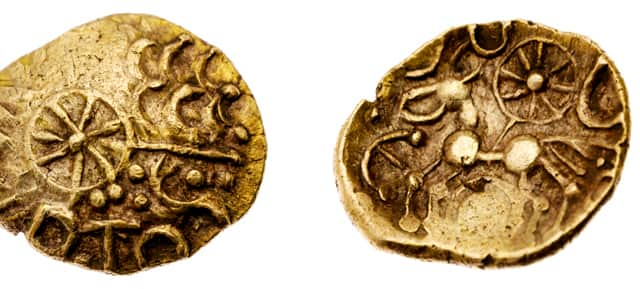British history books updated after coin found in Hampshire with stamp of unrecorded king sells for world record £20,000


British history books will need to be updated with a new King after a historic coin was found in a Hampshire field that fetched more than £20,000 at auction. The coin is smaller than a human fingernail and is stamped with the name of a previously unrecorded Iron Age ruler.
Described by experts as "one of the outstanding discoveries of recent decades", the coin dates to around 50 BC and bears a stamp that reads the name 'Esunertos'. The find was made by detectorist Lewis Fudge in a farmer's field.
Advertisement
Hide AdAdvertisement
Hide AdThe coin was dug up by Lewis in in March after he got permission to detect. It was struck sometime between 50 and 30 BC, shortly after Julius Caesar's first Roman raid of Britain in 55 BC.
Lewis said: “I am over the moon, if it were not for people in the auction room I would have jumped around. The collectors I spoke to are gobsmacked. I’m so glad I did not take them up on their private offers before the auction. To think my find has generated its own Wikipedia page, is incredible.”
The coin bears the name and it dates to the very beginning of written language appearing in the British Isles.


Expected to fetch around £4,000, frenzied bidding at auctioneers Spink saw the price rise to £20,400, including premium, beating the world record for a similar type of coin, a ‘Medusa’ Quarter-Stater set at £10,800.
Advertisement
Hide AdAdvertisement
Hide AdJulius Caesar landed on the Kent coast from a fleet of ships carrying 20,000 Roman soldiers. Waiting for them on the beach were thousands of Celtic warriors but the Romans were forced to return home after struggling to land and rough seas wrecking their boats.
Caesar returned the following year with 50,000 soldiers defeating many tribes and marching all the way to the River Thames. But after three months of fighting, they left to stop a rebellion in Gaul.
The long-term settlement of Britain by Rome didn't occur until 43 AD when Claudius was emperor. Leading Iron Age experts have since studied the coin and deduced it to be struck by a pre-eminent male figure dubbed ‘IISVNIRTOS’ whose name translates as ‘Mighty as the God Esos’.
One theory is that he possibly ruled as King from nearby Danebury hillfort - also in Hampshire.
Advertisement
Hide AdAdvertisement
Hide AdDr John Sills of the Celtic Coin Index at the Ashmolean Museum said: "It is one of the outstanding discoveries of recent decades in Celtic numismatics."
Gregory Edmund, Iron Age Coin Specialist at auctioneers Spink who led the team of experts in the recording of this new find added: “This fabulous piece of prehistoric artwork completes the mental image we have when we think of Iron Age Britain – the war horse and chariot. But it also surprises us with the appearance of classical languages like Latin.
“This is the reason I come to work; to document the discoveries of national importance and share that knowledge directly with museums and amongst academics, collectors and the public at large. On a personal note, this find is particularly vindicating for me. I focused my university degree on the Roman invasion of Britain through the lens of Britain’s first coinage.
"To now add a critically important contemporary witness to those seismic events in the birth of our island’s story is electrifying. Despite the coin’s diminutive size, the name of its conceiver - Esunertos - now truly echoes down the ages. Esunertos was once forgotten, but now his name looms large in the historic record."
Comment Guidelines
National World encourages reader discussion on our stories. User feedback, insights and back-and-forth exchanges add a rich layer of context to reporting. Please review our Community Guidelines before commenting.
